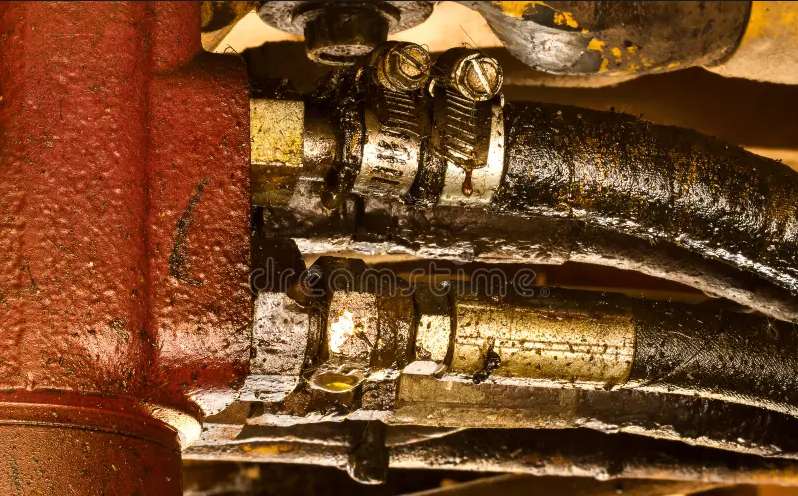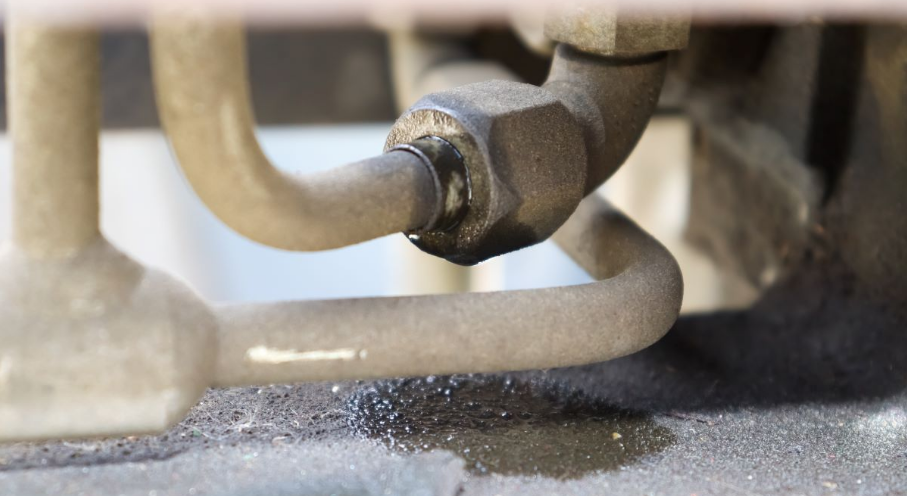Frustrated with hydraulic fluid puddles under your Kubota tractor? This comprehensive guide walks you through identifying, testing, and repairing common hydraulic leaks—saving you hundreds in mechanic fees with DIY-friendly steps. Learn to replace seals, diagnose system pressure issues, and choose between OEM and aftermarket parts for lasting repairs.
Signs Your Kubota Has Hydraulic Leaks
Recognizing hydraulic system issues early can prevent costly repairs and equipment downtime. Watch for these telltale symptoms that indicate potential hydraulic leaks in your Kubota tractor:
- ● Puddles under the tractor: The most obvious sign of hydraulic issues—fluid pooling underneath your parked tractor indicates ruptured hoses or failed cylinder seals.
- ● Sluggish implement response: When your loader or attachments move slower than usual or lack power, low fluid pressure from leaks may be the culprit.
- ● Unusual whining noises: Air ingress from low fluid levels or pump cavitation often produces distinctive sounds during operation.
- ● System overheating: Contaminated fluid or internal leaks strain your hydraulic system, causing temperature increases and potential damage to components.
Hydraulic System Pressure Testing
Before replacing components, perform a pressure test to accurately diagnose hydraulic issues and ensure your repair addresses the root cause:
Required Tools
- 3000 PSI hydraulic pressure gauge ($35–$60)
- Appropriate fittings for your tractor model
- Basic hand tools
Testing Procedure
- 1 Warm up the system: Run your tractor for approximately 30 minutes to bring hydraulic fluid to operating temperature.
- 2 Connect the gauge: Attach your pressure gauge to the rear hydraulic test port. If your model lacks a dedicated test port, you may need to use a T-fitting at the pump outlet.
- 3 Run the test: Set engine speed to approximately 2500 RPM and activate the hydraulics while monitoring pressure readings.
Interpreting Results
- Normal pressure: Most Kubota models should maintain 2090–2200 PSI under load.
- Low pressure (e.g., 2050 PSI): Indicates worn components or relief valve issues. Consider adjusting relief valve shims (30 PSI increase per 0.10mm shim).
- Erratic readings: May indicate fluid contamination or aeration. Replace filters and flush the system.
Safety Warning: Always depressurize the hydraulic system before disconnecting any components. Hydraulic fluid under pressure can cause serious injury.
Step-by-Step Seal and Hose Replacement
O-Ring and Rod Seal Replacement
- 1 Depressurize the system:
- Lower all implements to the ground
- Turn off the engine
- Move hydraulic control levers in all directions several times
- Disconnect the battery negative terminal for safety
- 2 Remove the hydraulic cylinder:
- Place a container underneath to catch fluid
- Thread fishing line through hose connections before removal to guide reinstallation
- Extract retaining pins and disconnect hydraulic lines
- Cap all openings to prevent contamination
- 3 Disassemble the cylinder:
- Secure the cylinder body in a vise with protective jaw covers
- Unscrew the gland nut (typically requires 440 lb.ft torque)
- Carefully extract the rod assembly
- Remove old seals using non-metal tools to avoid damaging surfaces
- Use brass shim stock to protect seal edges during replacement
- 4 Reassemble with new seals:
- Clean all components thoroughly
- Inspect the rod and cylinder walls for scoring or damage
- Lubricate new seals with clean hydraulic oil
- Install seals in the correct orientation (lip direction matters)
- Reinstall the rod assembly and torque the gland nut to specifications
Hydraulic Hose Repair
Leak Identification
- Thoroughly clean suspected areas and run the tractor to detect fresh fluid trails
- Inspect for cracks near fittings and connection points
- Check for damaged threads or deformed sealing surfaces
Replacement Procedure
- 1 Match specifications: Record length, diameter, and fitting types before ordering replacements
- 2 Select quality components: Use OEM hoses ($50–$150) or Parker Hannifin equivalents ($30–$90)
- 3 Install properly: Apply appropriate thread sealant to JIC/ORB fittings (never use Teflon tape)
Pro Tip: Take photos of hose routing before removal to ensure correct reinstallation. Incorrect routing can cause premature wear and future leaks.
Cost Comparison: OEM vs. Aftermarket
Understanding your options helps balance quality and cost-effectiveness when replacing hydraulic components:
Kubota OEM Advantages
- Guaranteed compatibility with your specific model
- Manufactured to original equipment specifications
- Often includes comprehensive installation instructions
- May be covered under remaining warranty
Parker Hannifin Benefits
- Cost savings of 20-40% over OEM parts
- TPU seals tolerate extreme temperatures (-35°F to +250°F)
- Meet ISO 6020/1 international standards
- Wider availability through multiple suppliers
Price Comparison Table
| Component | Kubota OEM | Parker Hannifin | Savings |
|---|---|---|---|
| Cylinder seal kit | $68–$85 | $52–$74 | ~15-25% |
| Hydraulic hose | $90–$150 | $65–$120 | ~20-30% |
| O-ring (NBR) | $4 | $2 | 50% |
Material Compatibility Note: Parker’s TPU seals offer excellent temperature resistance, while Kubota’s nitrile seals are optimized for standard agricultural applications. For extreme operating conditions, material selection matters more than brand.
Real-World Case Study: LA463 Loader Cylinder Rebuild
This real-world example demonstrates how one Kubota owner successfully repaired a leaking loader cylinder:
Project Overview
- Equipment: Kubota LA463 front loader
- Problem: Leaking lift cylinder causing decreased lift capacity
- Parts cost: $44.45 aftermarket seal kit
- Time investment: 3.5 hours for a first-time rebuild
Repair Process
- Removed the cylinder from loader arms using basic hand tools
- Disassembled the gland and carefully extracted the piston rod
- Created a simple 3D-printed slide jig to assist with seal installation
- Replaced both piston and rod seals without damaging components
- Reassembled and pressure tested before reinstallation
Results
The rebuild restored full lift capacity with zero leaks post-repair. The owner estimated saving over $300 compared to professional repair services, plus eliminated equipment downtime waiting for shop availability.
Common Mistakes to Avoid
Even experienced mechanics sometimes make these avoidable errors when addressing hydraulic leaks:
- Installing seals backward: Always check orientation—the lip typically faces the pressure side
- Contaminating components: Work in a clean environment and cap openings immediately
- Overlooking damaged surfaces: Inspect cylinders for scoring that will damage new seals
- Using excessive force: Never use metal tools that can scratch precision surfaces
- Mixing incompatible fluids: Use only manufacturer-recommended hydraulic fluid
- Forgetting to bleed air: Trapped air causes erratic operation and accelerated seal wear
Remember: Quality repair starts with proper diagnosis. Don’t assume a leak’s source—verify with pressure testing and methodical inspection before ordering parts.
Preventative Maintenance Tips
Extend the life of your hydraulic system with these proactive maintenance practices:
Fluid Management
- Check fluid levels weekly during heavy use periods
- Replace filters according to manufacturer schedule
- Analyze fluid annually for contamination and degradation
- Use only specified fluid types and viscosities
Connection Care
- Inspect fittings and hoses monthly for early wear signs
- Tighten loose connections promptly but avoid over-tightening
- Clean quick-connect couplers before attachment
- Protect exposed hydraulic components from sun and elements
Pro Tip: Create a simple maintenance log to track hydraulic system pressure readings over time. Gradual pressure drops can signal developing issues before catastrophic leaks occur.
Frequently Asked Questions
How do I find the exact source of a hydraulic leak?
To pinpoint leak sources, first thoroughly clean the suspected area with degreaser and compressed air. Run the tractor and hydraulic system for 15-20 minutes, then inspect for fresh fluid trails. For hard-to-spot leaks, apply talcum powder around suspected areas—hydraulic fluid will create visible paths through the powder. Remember to check both pressurized and return lines, as leaks can occur in either.
Can I reuse old hydraulic fluid after a repair?
Reusing hydraulic fluid is only recommended if it can be properly filtered and isn’t contaminated. Even microscopic particles can accelerate pump wear and damage newly installed seals. For best results, always use fresh fluid that meets Kubota’s specifications after major repairs. If budget constraints require reuse, filter the fluid through a 5-micron filter and visually inspect for clarity, odor, and consistency before reinstallation.
Are aftermarket hydraulic seal kits reliable?
Quality aftermarket seals from reputable manufacturers like Parker Hannifin meet ISO 6020/1 standards and often perform comparably to OEM components. For critical applications, stick with established brands that provide material specifications and compatibility charts. The most important factors are correct sizing and material compatibility with your hydraulic fluid and operating conditions. Temperature extremes, exposure to chemicals, and specialized applications may warrant OEM seals despite the higher cost.
How long do hydraulic seal repairs typically last?
Properly installed quality hydraulic seals typically last 2,000-3,000 operating hours under normal conditions. Factors affecting longevity include operating temperature, pressure fluctuations, fluid cleanliness, and cylinder alignment. Preventative maintenance practices like regular fluid and filter changes can significantly extend seal life. Signs that seals are nearing the end of their lifespan include minor weeping at cylinder ends, increased drift of suspended implements, and gradually decreasing system pressure readings.
Conclusion: The Value of DIY Hydraulic Repairs
Addressing Kubota hydraulic leaks yourself offers significant advantages beyond cost savings:
- Deeper equipment knowledge: Understanding how your hydraulic system functions helps with future troubleshooting
- Reduced downtime: No waiting for service appointments or parts shipping to dealers
- Quality control: Personal oversight of component selection and installation accuracy
- Skill development: Each repair builds mechanical knowledge transferable to other maintenance tasks
By following this guide’s systematic approach—from identifying symptoms and testing pressure to selecting components and performing careful installation—you can successfully repair Kubota hydraulic leaks and maintain optimal equipment performance for years to come.
Last Updated: April 27, 2025
Check us out for more at TractorPartsCentral.com



